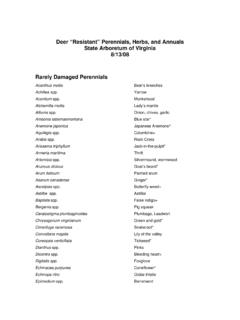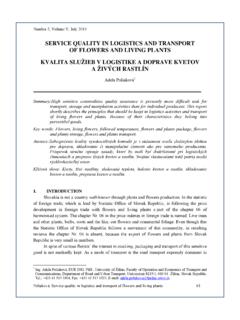Transcription of Common Plants Toxic to Dogs and Cats
1 Australia s state-of-the-art pet emergency trauma centres Caring for Sick and Injured Pets Since 1975 1300 AECVET or 1300 232 838 Common Plants Toxic to Dogs and Cats Lilies Toxin: Unknown Toxic compound in Lilium and Hemerocallis spp. The entire plant is Toxic . Cats are exceptionally susceptible to toxicity. Symptoms: Include vomiting (often contains pieces of lily) and signs associated with kidney failure including disinterest in food, depression, vomiting, and no urination. Recommendation: Seek veterinary attention immediately. Marijuana Toxin: Delta-9-THC. Symptoms: Ingestion of Cannabis sativa by companion animals can result in depression of the central nervous system and in- coordination, drowsiness or excitation, as well as vomiting, diarrhoea, drooling, increased heart rate, and even seizures and coma. Recommendation: Seek veterinary attention for symptomatic care. Cyclamen Toxin: Terpenoid saponins (cyclamine).
2 All parts of the plant are Toxic , however, the highest concentration of the toxin is in the root portion of the plant. Symptoms: Include significant gastrointestinal irritation, including intense vomiting drooling and diarrhoea. Fatalities have also been reported due to heart rhythm abnormalities and seizures. Recommendation: Seek veterinary attention for symptomatic care. Seek attention immediately if a bulb has been ingested. Sago Palm Toxin: Cycasin. All parts of Cycas Revoluta are poisonous, but the seeds or nuts contain the largest amount of toxin. The ingestion of just one or two seeds can result in very serious effects. Symptoms: Include vomiting, diarrhoea, black or bloody stools, bruising, yellow discolouration to skin, seizures and liver failure. Recommendation: Seek veterinary attention immediately. Tulip/Narcissus Bulbs Toxin: Tulipalin A and B. The bulb portions of Tulipa/Narcissus spp. contain the highest portions of the toxins. Symptoms: Include intense gastrointestinal irritation causing drooling, loss of appetite, vomiting and diarrhoea, depression of the central nervous system, convulsions and cardiac abnormalities.
3 Recommendation: Seek veterinary attention for symptomatic care. Azalea/ Rhododendron Toxin: Grayantoxin Symptoms: Include vomiting, drooling, diarrhoea, weakness, loss of coordination and depression of the central nervous system. Severe poisoning could ultimately lead to coma and death from cardiovascular collapse. Recommendation: Seek veterinary attention for symptomatic care. Oleander Toxin: Cardiac glycosides. All parts of Nerium oleander are Toxic . Symptoms: Include gastrointestinal tract irritation causing drooling, vomiting, diarrhoea (may be bloody), loss of coordination, shallow breathing, muscle tremors, hypothermia and even death from abnormal heart function. Recommendation: Seek veterinary attention immediately. Kalanchoe Toxin: Bufadienolide cardiac glycosides. Symptoms: Include gastrointestinal irritation causing vomiting and diarrhoea, as well as abnormalities of the heart rhythm and rate which can cause death (rare). Recommendation: Seek veterinary attention for symptomatic care.
4 Yew Toxin: Taxine. Symptoms: Include sudden death from acute heart failure. Earlier signs include vomiting, muscle tremors, loss of coordination, abnormal breathing and seizures. Recommendation: Seek veterinary attention immediately. Chrysanthemum Toxin: Pyrethrins. Symptoms: Include drooling, vomiting and diarrhoea, depression and loss of coordination. Recommendation: Seek veterinary attention for symptomatic care. Amaryllis Toxin: Lycorine and others. Symptoms: Include vomiting, depression, diarrhoea, abdominal pain, drooling, inappetance and tremors. Recommendation: Seek veterinary attention for symptomatic care. Autumn Crocus Toxin: Colchicine and other alkaloids. Symptoms: Include drooling, vomiting (may contain blood), diarrhoea, shock, multi-organ damage and bone marrow suppression. Recommendation: Seek veterinary attention immediately. English Ivy Toxin: Triterpenoid saponins (hederagenin). There is a higher concentration of the toxin in the leaves than the berries.
5 Symptoms: Include vomiting, abdominal pain, drooling and diarrhoea. Recommendation: Seek veterinary attention for symptomatic care. Peace Lily/Pothos/Schefflera Toxin: Insoluble calcium oxalates. Symptoms: If chewed or ingested, can cause significant irritation of the mouth leading to drooling, vomiting and difficulty swallowing. Recommendation: Seek veterinary attention for symptomatic care.




